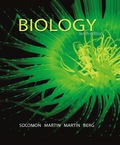
Concept explainers
To compare: The sketch diagrams illustrating a proton gradient involved in the chloroplast and mitochondria.
Introduction: Photosynthesis is a process by which carbon dioxide and water are used to produce glucose molecules using energy from sunlight. During this process, oxygen gas is evolved. Reactions of photosynthesis take place in the chloroplast of the plant cell that contains the green pigment chlorophyll.
To determine: Whether, in each sketch, the protons are being pumped into the inner most compartment or out of it.
Introduction: Photosynthesis is a process by which carbon dioxide and water are used to produce glucose molecules by using energy from sunlight. During this process, oxygen gas is evolved. The several reactions of the photosynthesis take place in the chloroplast of the plant cell that contains the green pigment chlorophyll.
To determine: Whether the direction of proton gradient matters in the chloroplast and mitochondria.
Introduction: Photosynthesis is a process by which carbon dioxide and water are used to produce glucose molecules by using energy from sunlight. During this process, oxygen gas is evolved. Reactions of the photosynthesis take place in the chloroplast of the plant cell that contains the green pigment chlorophyll.
Trending nowThis is a popular solution!

Chapter 9 Solutions
EBK BIOLOGY
- Other than oil and alcohol, are there other liquids you could compare to water (that are liquid at room temperature)? How is water unique compared to these other liquids? What follow-up experiment would you like to do, and how would you relate it to your life?arrow_forwardSelection of Traits What adaptations do scavengers have for locating and feeding on prey? What adaptations do predators have for capturing and consuming prey?arrow_forwardCompetition Between Species What natural processes limit populations from growing too large? What are some resources organisms can compete over in their natural habitat?arrow_forward
- Species Interactions Explain how predators, prey and scavengers interact. Explain whether predators and scavengers are necessary or beneficial for an ecosystem.arrow_forwardmagine that you are conducting research on fruit type and seed dispersal. You submitted a paper to a peer-reviewed journal that addresses the factors that impact fruit type and seed dispersal mechanisms in plants of Central America. The editor of the journal communicates that your paper may be published if you make ‘minor revisions’ to the document. Describe two characteristics that you would expect in seeds that are dispersed by the wind. Contrast this with what you would expect for seeds that are gathered, buried or eaten by animals, and explain why they are different. (Editor’s note: Providing this information in your discussion will help readers to consider the significance of the research).arrow_forwardWhat is the difference between Uniporters, Symporters and Antiporters? Which of these are examples of active transport?arrow_forward
- What are Amyloid Fibrils? What biological functions are these known to perform?arrow_forwardHow do histamine and prostaglandins help in the mobilization of leukocytes to an injury site? What are chemotactic factors? How do they affect inflammation process?arrow_forwardCompare and contrast neutrophils and macrophages. Describe two ways they are different and two ways they are similar.arrow_forward
 Biology (MindTap Course List)BiologyISBN:9781337392938Author:Eldra Solomon, Charles Martin, Diana W. Martin, Linda R. BergPublisher:Cengage Learning
Biology (MindTap Course List)BiologyISBN:9781337392938Author:Eldra Solomon, Charles Martin, Diana W. Martin, Linda R. BergPublisher:Cengage Learning Concepts of BiologyBiologyISBN:9781938168116Author:Samantha Fowler, Rebecca Roush, James WisePublisher:OpenStax College
Concepts of BiologyBiologyISBN:9781938168116Author:Samantha Fowler, Rebecca Roush, James WisePublisher:OpenStax College

